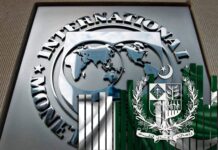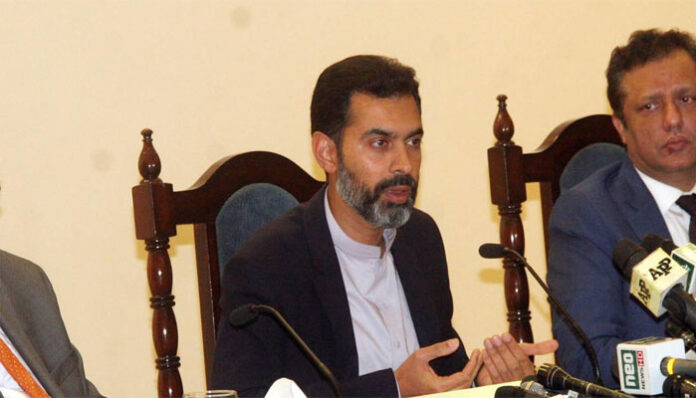KARACHI: As the country’s economy is stabilising, attention needs to be given to pivoting Pakistan from an inward economy to an outward-looking one, State Bank of Pakistan (SBP) Governor Dr Reza Baqir said on Monday.
He was addressing the Firms and Growth Seminar at the SBP, held in collaboration with the International Growth Centre (IGC), the Pakistan Business Council (PBC) and the Consortium for Development Policy Research (CDPR).
The event also featured comments from Adviser to Prime Minister in Finance and Revenue Dr Hafeez Shaikh and Planning & Development Minister Asad Umar.
In a frank and candid presentation to industry heads and economists, all three in their separate speeches emphasized that Pakistan’s export sector was lagging and sluggish, and needed to change in order to grow. The three men also emphasized how a market-determined exchange rate was a welcome decision, and has been instrumental in improving the economy.
DR REZA BAQIR
In his presentation, Dr Reza Baqir said Pakistan must change the orientation of the economy from an inward-looking one, based on consumption in non-tradable sector to an outward economy, based on sustainable exports.
According to the governor, stabilisation has been successfully achieved due to the reform programme, and the state bank believes growth will rise: the question is how much will it rise by, and will it be sustained?
Highlighting the history of Pakistan’s exports, Dr Baqir said that Pakistan’s exports have lagged behind competitor countries for the last 20+ years, except for a brief period between 2000 and 2006.
The reason for this sluggish growth was an overvalued exchange rate that was constraining exports.
He also said that export growth in Pakistan slowed down after 2012, and that diversification of exports has been limited through 2017. In fact, if Pakistan had continued at the same growth rate, it would have made a difference of $40 billion, according to the governor’s estimate.
To make his point more forcefully, Dr Baqir compared Pakistan to developing countries, Bangladesh and Vietnam. Bangladesh, has a higher growth rate, propelled mostly by its textile exports. However, Bangladesh has specialized almost exclusively in the textile sector. Meanwhile, Vietnam not only shows a strong growth rate, but also a diversification of exports.
DR HAFEEZ SHAIKH
Dr Hafeez Shaikh posited the question: why has Pakistan been unable to grow? The effective finance minister said that in 72 years, Pakistan has not seen a growth period longer than four years, and that the country only has growth spurts, not long-term growth trends. He summed it up as “why do we never lose an opportunity to lose an opportunity?”
Dr Shaikh also highlighted the difficulties of what the government inherited, pointing to the unsustainable exchange rate, high current account deficit, poor growth in agriculture, and general sluggish economy overall. The adviser also said the IMF programme was necessary as a ‘signal to the world’, for Pakistan to have some credibility globally.
To go from the stabilisation to sustained economic growth, Dr Shaikh said the lead must come from the private sector. The advisor also expressed mild frustration with the business community, saying that often times businessmen in the country were not willing to do business more extensively with the outside world, and that Pakistanis were not going to the frontiers [of the world] and selling their products.
Though he said that that low exports were partially due to government constraints, the importance of the government should not be over exaggerated
ASAD UMAR
As per Asad Umar, the current planning minister and former finance minister, any time Pakistan’s economy is over 4pc it runs into problems. This is because of a cyclical problem that he described as Pakistan’s economy having short growth spurts, followed by a balance of payments problem, and so on.
He also candidly said the overvalued exchange rate was not just an ‘Ishaq Dar’ problem, but in fact the exchange rate has been consistently over valued for long time periods in the last 25 years, revealing a structural bias in Pakistan.
Asad Umar also pinned the lack of competitiveness in the economy on structural problems, in particular calling agriculture a ‘visible disaster’, especially in sugar and milk powder areas. As per the minister, agriculture productivity from 1960 to 1990 quadrupled, due to additional acreage and better farming techniques. That competitiveness has ended.
Asad Umar highlighted the difficult political implications of changing export growth, saying that the beneficiaries of the current status quo will not be beneficiaries of the new system, and will use financial resources and political connections to make sure changes do not happen.

























They choose to spend on an arms race with india instead of developing Pakistan’s human resources. Now they are surprised by our loss of competitiveness and low productivity. What did they think was going to happen?
*chose